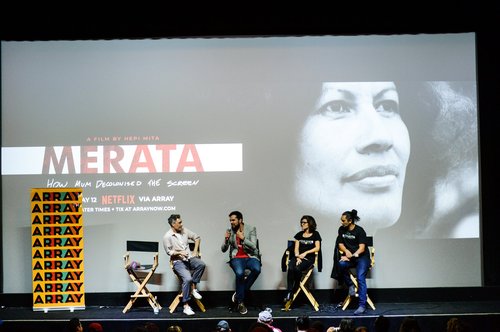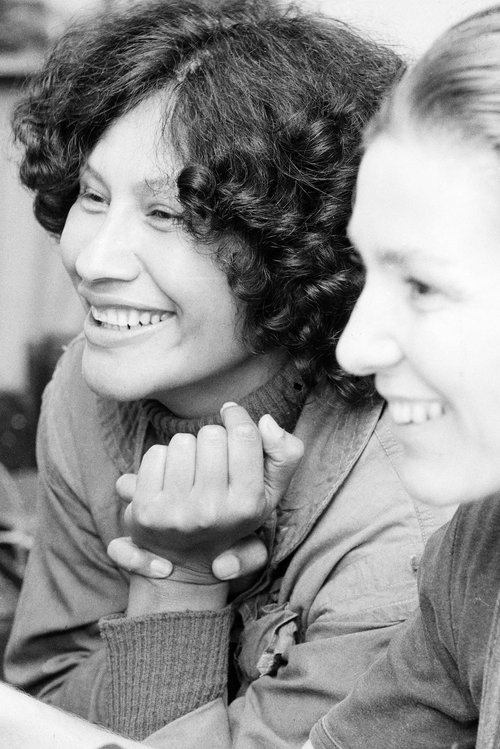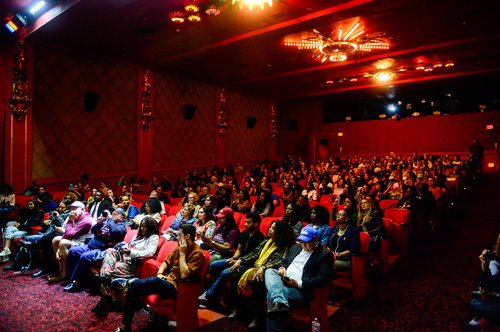
Filmmaker Heperi Mita talks about the experience, how the film has been received and getting it onto Netflix in North America.
It’s been flat-out the last few months for filmmaker and archivist Heperi Mita. “It’s very hectic sometimes!” he says. “Like, there were a bunch of screenings on Mother’s Day. I did a morning tea screening at 10am in Auckland, an afternoon tea at 4pm in Wellington, then jumped on a plane and flew to LA and did the official American premiere, all in the span of, I don’t know, 20 hours?”
Keeping him busy has been his documentary MERATA: How Mum Decolonised the Screen, which has been very successful and has been selected to screen all around the world: after its world premiere at the New Zealand International Film Festival it has screened at the Hawai’ian International Film Festival, Sundance, the Berlinale, HotDocs in Toronto and the Los Angeles Asian Pacific Film Festival. There was also the American premiere in Los Angeles, a screening at Doxa (Vancouver International Documentary Film Festival), as well as some screenings in the Big Apple for New York University.
“The film just does its own thing now. It’s been released into the world, like a bird leaving the nest,” says Heperi.

Taika Waititi, Heperi Mita, Chelsea Winstanley and Cliff Curtis Q and A panel at the American premiere of MERATA.
That’s a nice way to put it, but it’s been a lot of hard work over the last six years. Working as an archivist at Ngā Taonga, his day job has dovetailed nicely with the large amount of archival footage in the documentary. “That’s how I started on this whole process really,” reflects Heperi. “If I wasn’t working at the Archive, I would never have made the doco” – owing to the archival content on hand.
MERATA looks at the life and work of groundbreaking filmmaker Merata Mita, who is sometimes referred to as ‘the Grandmother of Indigenous Film’. It features her television documentary work, as well as the independent productions Patu! and Bastion Point: Day 507 and her feature film Mauri. It also highlights her work teaching in the United States and at Sundance. Alongside this though it tells a deeply personal story from the perspective of Heperi, her youngest son.
Heperi seems very much his mother’s son. His documentary is distinctly Māori, while also being international in scope. It deals with struggles and controversial topics, but with a caring and insightful lens. A similar connection arose when looking at the context of programming at each film festival. “At Berlin they had curated a range of indigenous films, and so selected the film about my mum,” explains Mita. “Sundance introduced the Merata Mita Fellowship in 2016 and it turned out that three of the films from that Fellowship were actually at the Berlinale as well. So it was like an interesting genealogy of her influence.”
Merata Mita created a huge legacy both in New Zealand and abroad. Merata Mita was an advisor to Sundance and was artistic director of the Sundance Institute NativeLab for nearly a decade, where she championed emerging Indigenous talent. She was also responsible for establishing and leading the indigenous filmmaking programme at the University of Hawai’i–Manoa and went on to be an assistant professor there. Heperi noticed the way the film has been received at festivals abroad, but also on general release in New Zealand. “There are a lot of people who worked with her overseas and knew her work from when she was teaching at the University, or mentoring at Sundance in different programmes,” says Heperi. “They didn’t know that background story of her personal life. And then, on the other hand, many New Zealanders knew her as ‘that activist’, but didn’t really know what she was up to overseas.”
Other parallels sprung up too. During the Q and A at Sundance, someone pointed out the similarity between the footage Merata shot of protests at Takaparawhā/Bastion Point in 1980 and what had happened recently in the United States with protests at Standing Rock about the Dakota Access Pipeline. “It’s a very similar thing where people were getting kicked off the land,” says Heperi. “It hit a really strong chord about what was happening there, and all these parallels are things that continue to happen. I guess it’s indicative of the issues facing minority groups in modern society.”
This range of response speaks to the different levels at which the film resonates with people. “Sometimes it’s at a very personal level. And sometimes more generally at a societal level,” reflects Heperi.
Along with the large amount of archival footage and interviews with other filmmakers, MERATA has plenty of interviews with members of the Mita whānau. As well as being a pioneer filmmaker, Merata raised six children on her own and they all played a role in the film. “It was such a personal process, because I’m interviewing my own family. It’s all very inward reflecting,” describes Heperi. “And so then when you do release it and it receives the response it’s had, that’s extremely gratifying. But even more so I think what I’ve been really happy with has been how the positive reaction has affected my family.” Getting everyone talking about what were often hard times has helped his siblings and relatives come to terms with some of the major issues of having an activist filmmaker mum – even thirty years later.
Heperi also feels that he stuck to his guns with his vision for the film. “It shows that you can do something that’s authentic to you. I never went out and sought to make ‘a product’ or anything. It’s all about representing the story and staying true to it. And people are interested and engaged and they want to see it, which is incredible.”

Merita Miita (Left, Director) and Annie Collins (Right, Editor) editing Patu!, May 1983. (Stills Collection, Ngā Taonga Sound and Vision (Ref S235855) - Courtesy of Jocelyn Carlin Collection and Mita whānau.)
Both Heperi and Merata were aware that their work falls inside a wider galaxy of indigenous cinema – what fellow filmmaker Barry Barclay called ‘Fourth Cinema’. “One of the coolest things was talking to other indigenous filmmakers,” says Heperi. “A lot of them are independents and they’re not household names at this stage, but they’re all super talented, super intelligent individuals.” More parallels emerged during screenings overseas, showing similarities between minority groups making films worldwide. “There was one indigenous filmmaker who was studying a case of wrongful accusation of an indigenous man in the States. And she was talking about how she’s a solo mum. When she was investigating that case, their household was receiving threats and that type of thing” – experiences the Mita whānau had to deal with too.

Ava DuVernay and Heperi Mita outside the American premiere of MERATA.
The North American distribution of the film is being handled by filmmaking powerhouse Ava DuVernay’s Array company – an organisation dedicated to the promotion of films by women and people of colour. “I got to meet Ava and it’s amazing to see what she’s doing in the States. She’s got her own compound where they have writers’ rooms, post-production facilities and meeting rooms, and they do all their publicity and screenings there. That was really, really inspirational, cause that’s all part of her mission to get minority voices out there and she’s built it from the ground up.”
“I know getting distribution in the States is a big deal,” says Heperi. “But what really hit home was when Ava tweeted about it, and she has like two million followers! It struck me that, holy crap, two million people just found out about my film.”
Plus, it’s on Netflix in North America. While sitting watching the channel talking to his sister Awatea, who also features in the film, Heperi says, “I was like, hey, you know what’s kind of crazy? We’ll be on this. You and I will be on this.”
Adding more incredulity, Disney Animation Studios scheduled a private screening for their staff members. “They’re super interested in documentary because they spend so much time in the realm of fantasy. A lot of what they programme to view internally helps ground them.” It was a real childhood geek-out moment for Mita. “I mean I grew up on that! Disney animation – that’s huge.”

The crowd at the American premiere of MERATA.
The film is currently in New Zealand theatres, where it had a very wide release. “As long as people keep going, it’ll keep screening,” Heperi says. He feels as though it’s had a long life already. “It came out in the New Zealand International Film Festival in August 2018. I didn’t realise that I would still be touring it around and screening it nearly a year later. The next screening coming up that I’m presenting is in June at the Sydney Film Festival.” Then there’s the Melbourne Film Festival as well.
Maybe after that Heperi can have some down time. The experience, though, has been a special one. “It’s an amazing, amazing privilege to be invited to these places. And although I may be tired, the audience reactions and the Q and As are always really lively and can be quite emotional. It’s nice to see people react the way they do, you know?”
Find out more about Merata Mita: E-Tangata essay by Heperi; NZ On Screen biography; Wikipedia.
Find out more about MERATA: How Mum Decolonised the Screen: Facebook; Twitter; Rotten Tomatoes reviews.